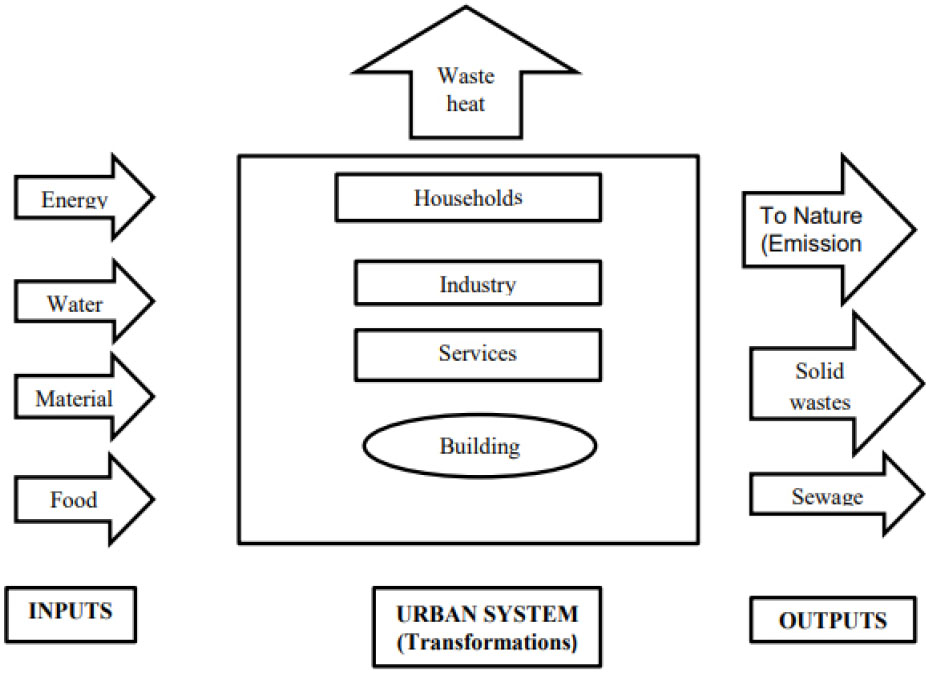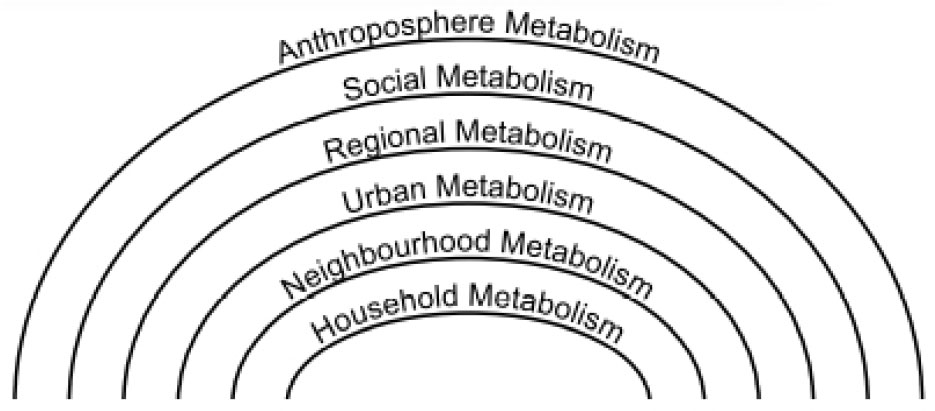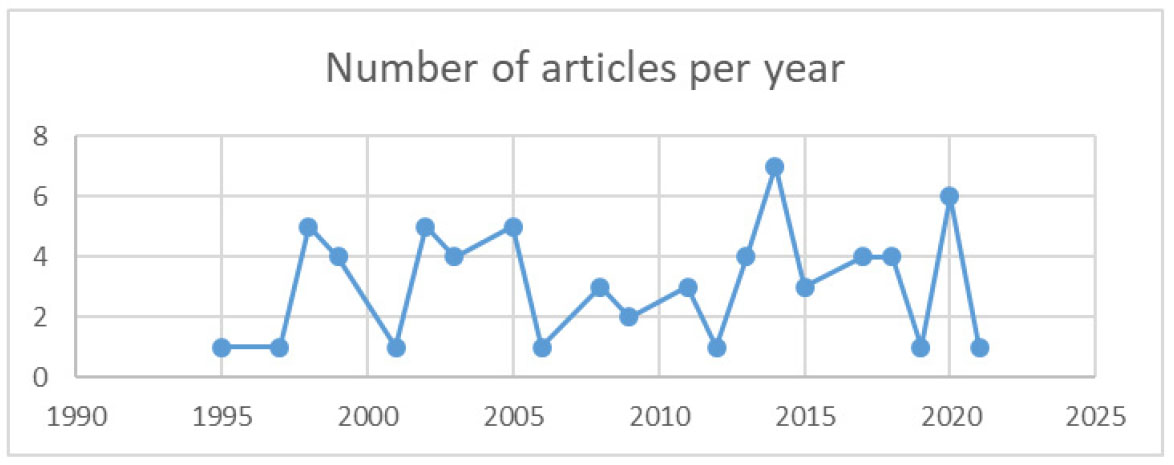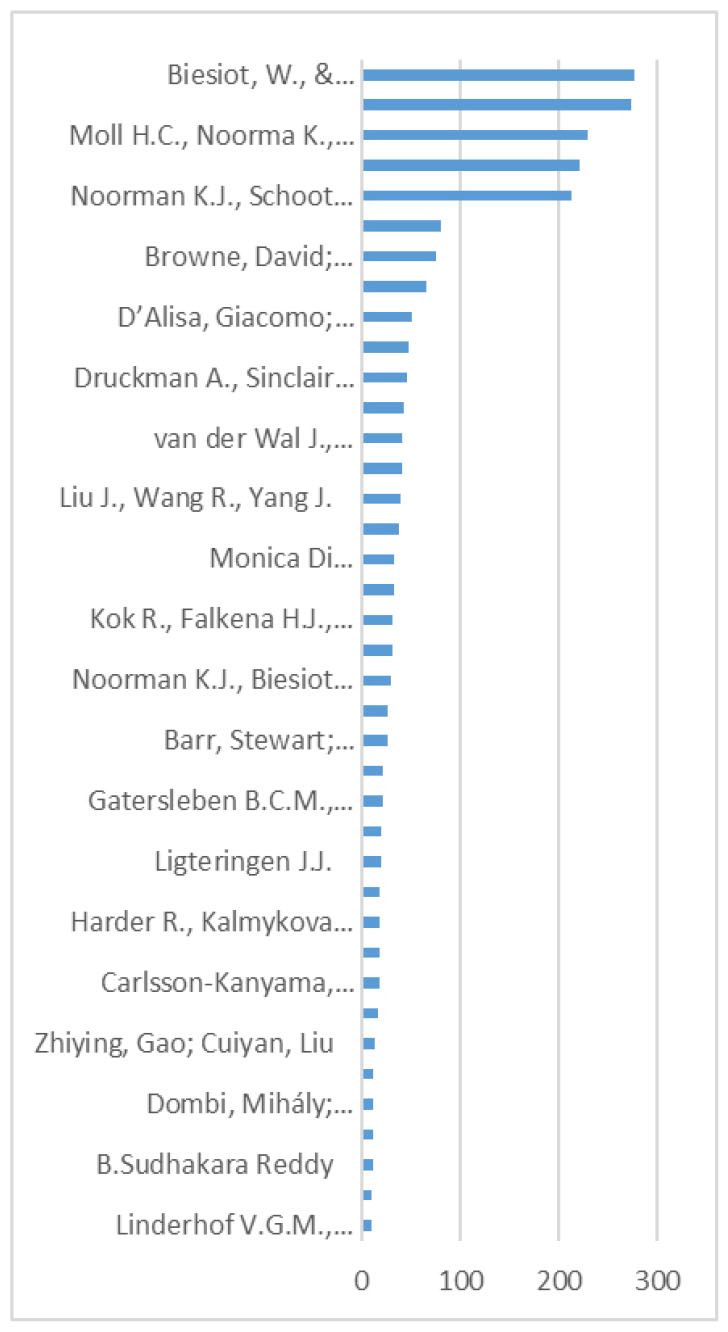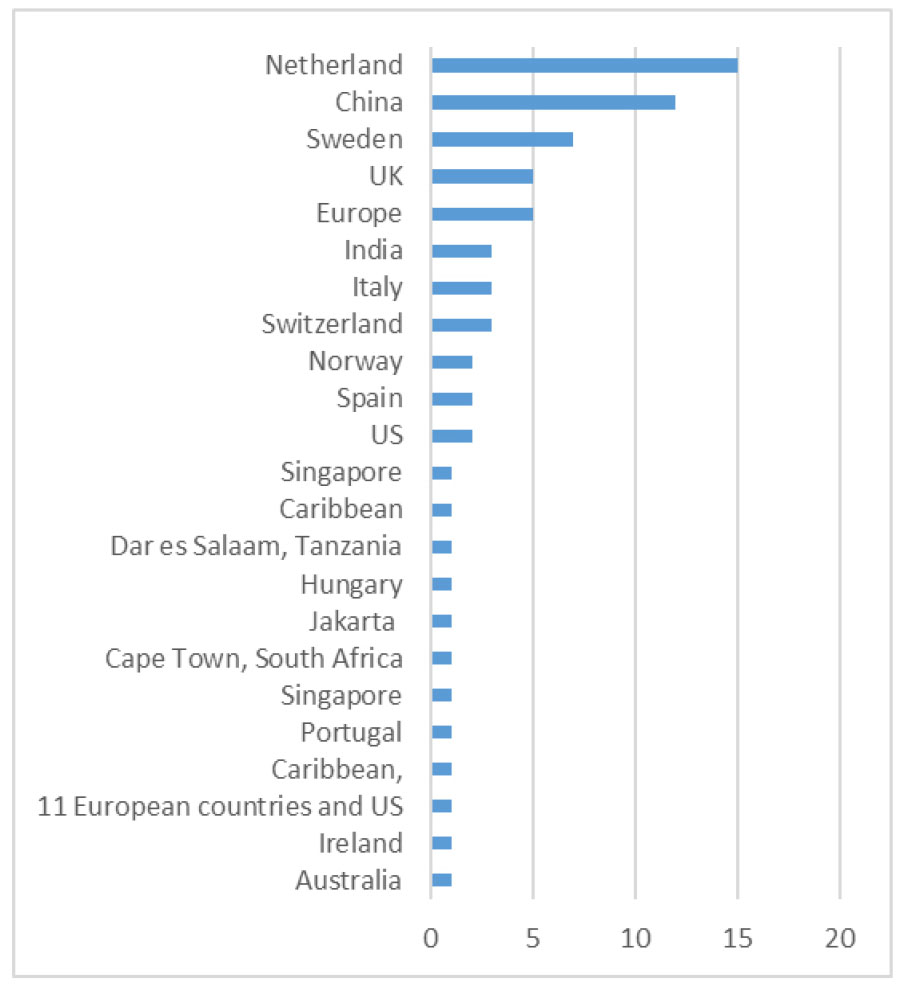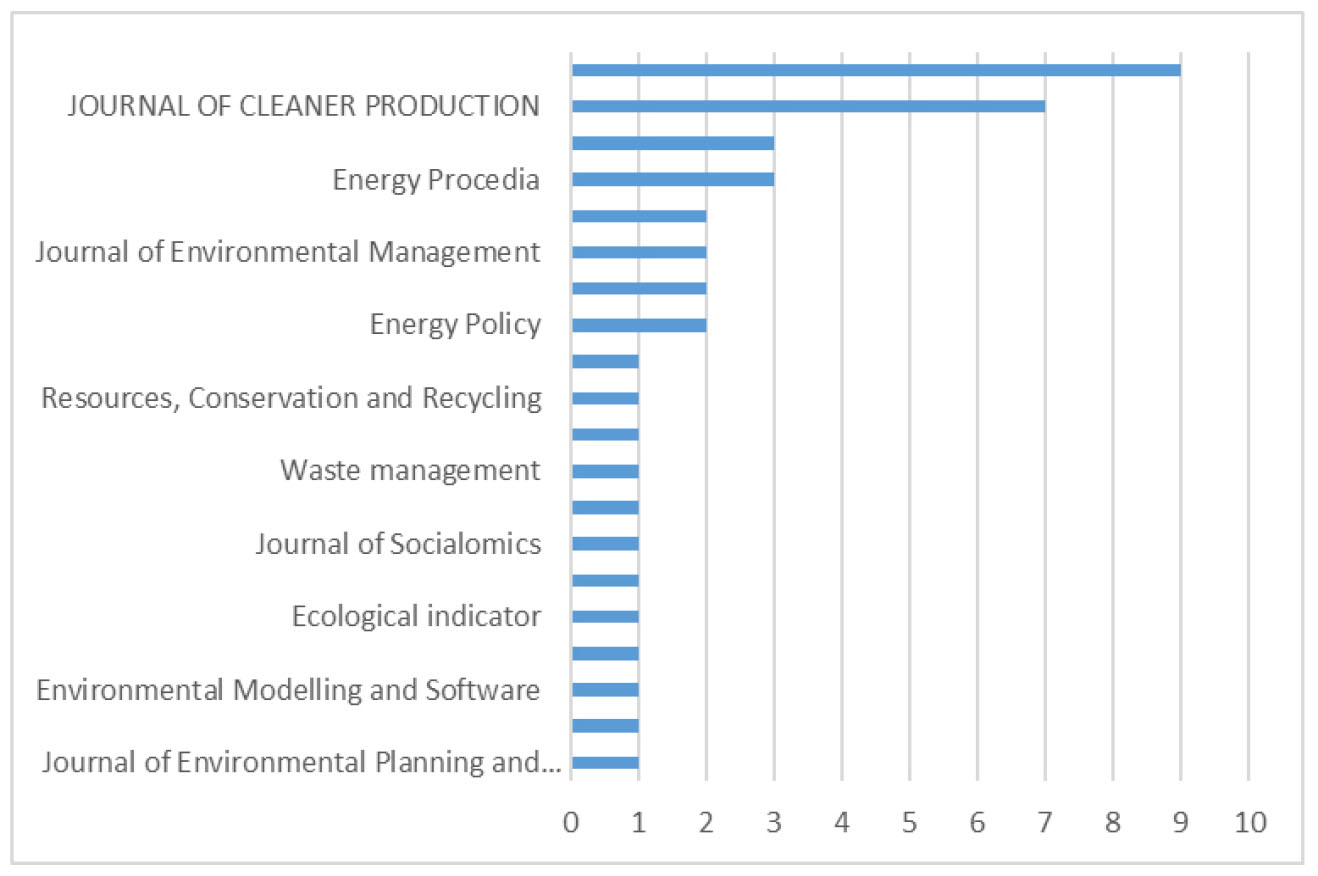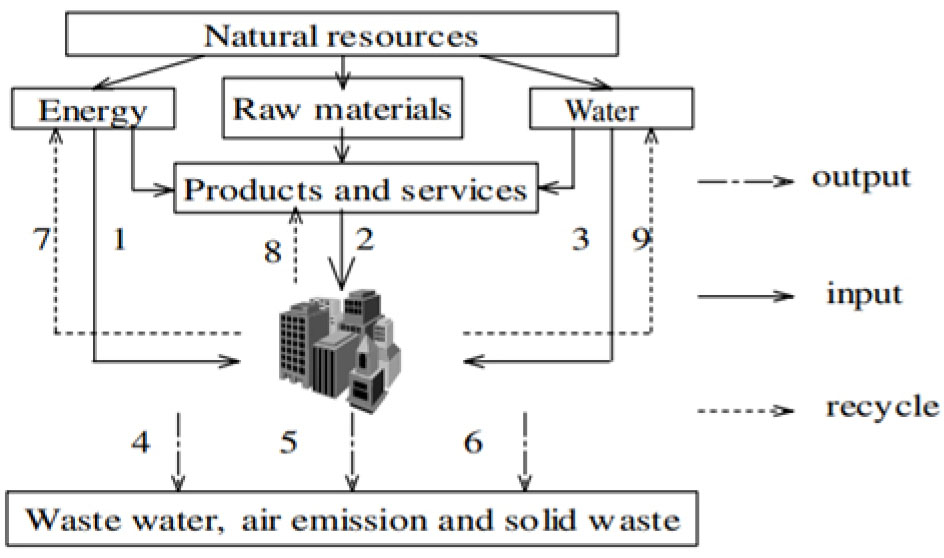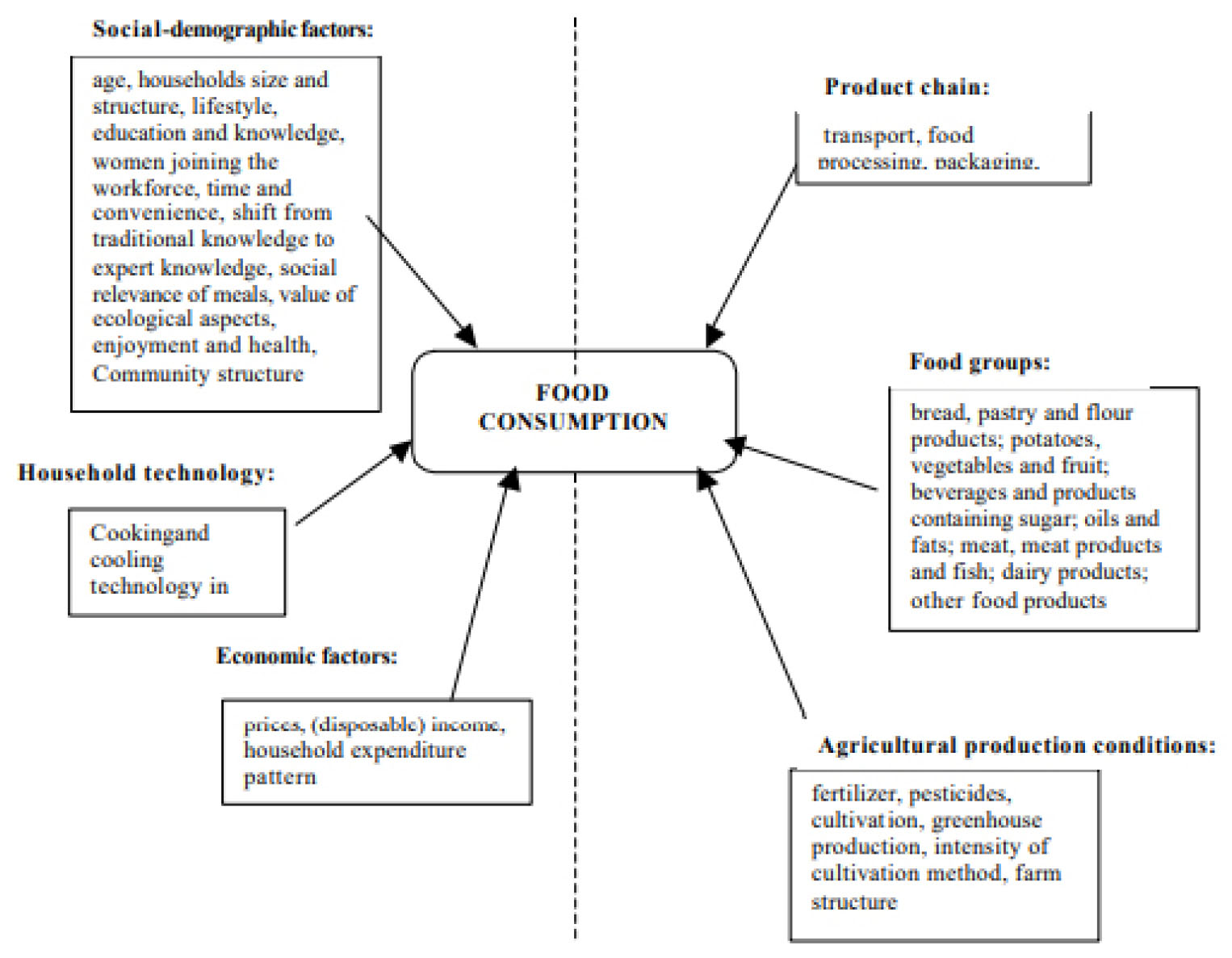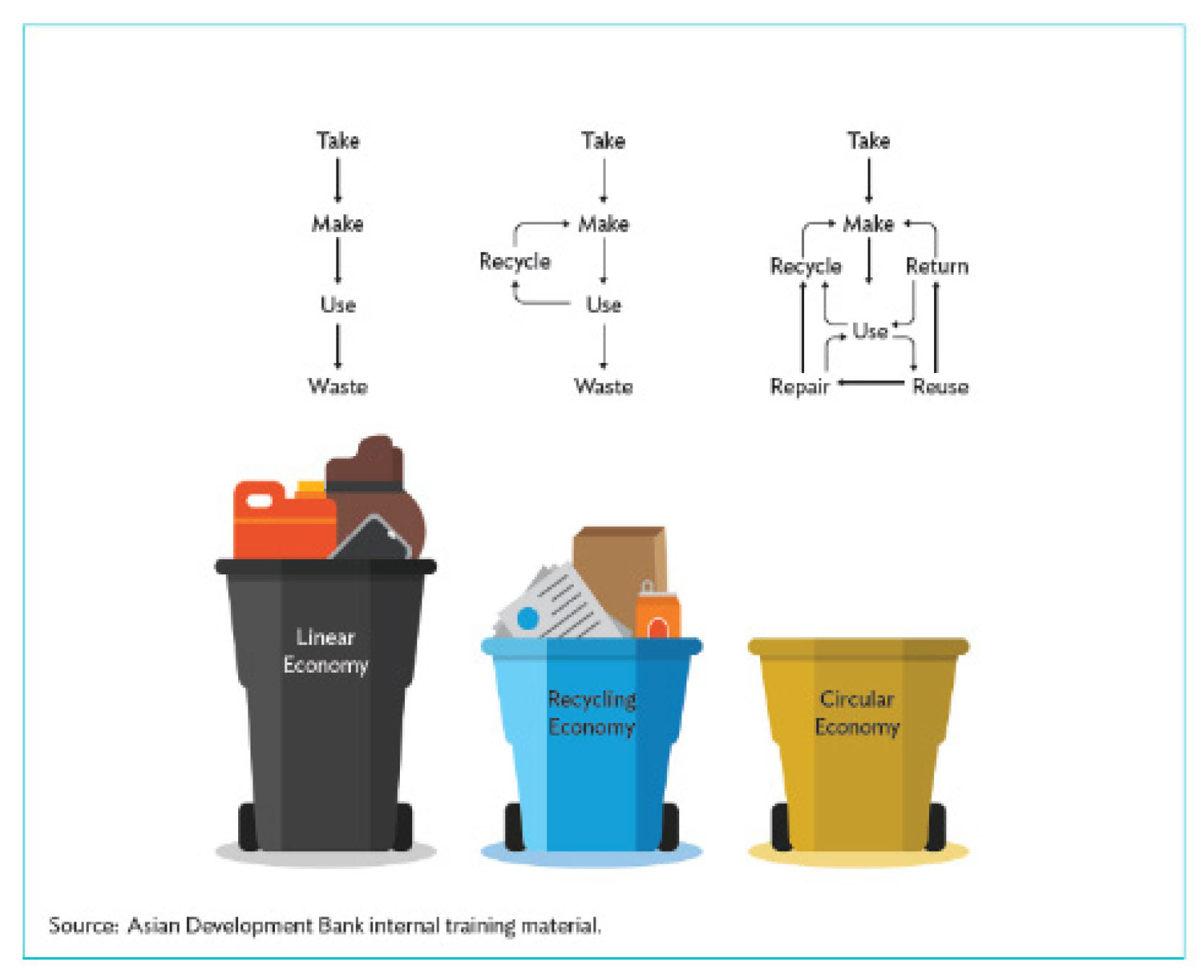Introduction
Background regarding cities and urban metabolism
An overview of household metabolism and consumption
Aims
Research question: household metabolism and household food waste
Methods and Materials
Systematic Literature Review: Methodology and Review of Household Metabolism
Quality Assessment
Included Studies
Results and discussion
Overview and general patterns
Urban Household Metabolism
Conclusion
Limitations and Recommendations
Introduction
Background regarding cities and urban metabolism
Due to rapid urbanisation, the environmental load connected with production and consumption activities in today’s cities is continually increasing. According to the United Nations, cities occupy more than 55% of the population, which is projected to increase to 68% by 2050 [1]. Cities are the biggest consumers of global resources, consuming 75% of the world’s resources (inputs) and generating more than 70% of the world’s greenhouse gas emissions and half of all global discharged materials into the environment (outputs), including emissions to the air from industrial and household wastes [2, 3, 4].
Growing cities and urbanisation make urban cities more complex, which is due to the continuous increase in production, consumption, and waste causing alteration of land to urban practices, reduction of natural resources, and the removal of urban waste [5] and [6].
Individual consumers and household activities have a crucial role at the urban level in terms of sustainable development plans, where unsustainable resource use causes air and water pollution, waste discharge, global climate change, and greenhouse gas emissions [7, 8, 9].
From a resource usage and management standpoint, urbanisation and its demographic characteristics have been studied [10]. A key topic is the idea of urban metabolism of debate on cities as promising in interdisciplinary research for facilitating appropriate measures of material consumption and waste recycling for achieving city sustainability [1, 11, 12, 13, 14], quantification of raw materials, and energy supply to indicate that resource usage and waste production are within the territorial or international load capacity or assimilative ability [15, 16].
“The urban metabolism of a city can be defined as all the materials and products needed to sustain the city’s citizens at home, at work, and at play... The metabolic cycle is not completed until the wastes and residues of daily life have been removed and disposed of with a minimum of nuisance and hazard” [17].
According to Kennedy et al. (2007), urban metabolism is the estimation of energy, water, nutrients, materials, and waste inputs, outputs, and storage in urban areas and is evaluated through material flow analysis (MFA), urban metabolism analysis, or ecological footprint (EF) analysis (as shown in Figure 1), as well as life cycle analysis [5]. Information about environmental inputs and outputs analysis and life cycle assessment is complemented with data on the environmental information associated with consumer goods and services as expenditure information. To better understand urban metabolism, there are a lot of moving parts in urban metabolism, and it’s important to know what factors influence the flows (see Figure 2).
The UM approach can maximise the efficiencies of the flows and reduce outputs such as pollution and waste [20]. It offers a thorough method of urban planning and investigates the relationships between waste streams, the standard of living, and resource flows and urbanization processes [15]. However, strategic urban planning systems that have been developed over the past decades based on the concept of urban metabolism have mainly focused on land use, transportation, and energy use [21]. Recently, several policies related to waste reduction, zero land consumption, and resource efficiency have been developed to help cope with these problems, and two key concepts have received attention: the circular economy (CE) and urban metabolism (UM).
Urban metabolism assessments differed by country, region, neighbourhood, and household [22, 23].
An overview of household metabolism and consumption
The household, defined as a group of people who together provide the provision of food, shelter, and other necessities for living, is a basic socio-economic unit in human societies, so understanding trends and patterns of family size and composition can guide efforts towards achieving the 2030 Agenda for Sustainable Development [1]. On the other hand, food waste is a significant waste stream coming from households. Agenda 21, Chapter 4, “Changing Consumption Patterns,” pointed out that unsustainable household consumption is a global environmental problem [24].
The urban metabolism study has increasingly progressed to a multi-scale level. The study included the home scale [25, 26] (Figure 3).
Household metabolism encompasses both the resource demand, which describes the materials and energy required to support these flows indirectly, as well as the direct flow of materials through homes, including emissions [28, 29]. This concept is identified as a contributing factor to the metabolic activity observed in metropolitan areas [29].
With the growing concern about climate change, researchers have looked into home greenhouse gas (GHG) emissions due to direct and indirect emissions. For instance, some researchers did not consider the individual effect of climate and considered it minor, i.e., the food waste in household metabolism, and no statistical confirmation has been made [30]. Therefore, it is suggested that individuals reassess how to address resource and environmental challenges through human activities on a local home level.
Households are represented as one process, converting food inputs into waste output [31]. The household waste came from consumer activities [32]. Solid waste is mostly treated in landfills; methane production has an environmental impact at the local and regional levels.
Household consumption necessitates the use of water, energy, and materials at all levels of the economic process, affecting the environment both directly and indirectly throughout the manufacturing process. Household consumption is a major contributor to rising environmental impacts such as natural resource depletion and trash generation [33]. Due to a paucity of data, insufficient research has looked at socio-economic metabolism and its effects on the environment at the household level.
Sustainable consumption and production (SCP) were defined by the Oslo Symposium in 1994 as the use of related services and products that respond to basic needs and achieve a better quality of life while reducing the use of natural resources and toxic materials, in addition to emissions of waste and pollutants over the life cycle of the service or product, so as not to affect the needs of future generations [34]. The concept of SCP was subsequently recognised in the Johannesburg Plan of Implementation, adopted in 2002 at the World Summit on Sustainable Development (Department of Economic and Social Affairs, 2015). All nations should promote sustainable production and consumption habits, with industrialised countries leading the way and all countries benefiting from the Rio+20 Action Plan [35].
The household sector is the main area of sustainable consumption research. The concepts of household metabolism are introduced in this systematic review to analyse the environmental impacts of household consumption. Household consumption levels are far beyond sustainable; as a result, an inclusive strategy could assist in taking meaningful steps in that direction [36, 37]. Since the household sector is considered to be a main producer of varied types of waste, household metabolism is of interest to scientific researchers and decision-makers for setting government policies aimed at minimising the risks of climate change and global air pollution [38]. To achieve sustainable consumption patterns in sustainable cities, we should comprehend household metabolism, its driving forces, and its potential for change.
The causes of household food waste are complex and not yet fully understood, particularly how food consumption affects waste production. While major environmental impacts are derived from food production (agriculture, food processing), families influence these impacts through their food choices and habits. This, in turn, impacts the environment due to energy consumption and waste generation associated with food.
In the course of our investigation, we came across two recent systematic reviews of the current literature on household food waste. Schanes et al. (2018) conducted the first review, which identified processes involved in household food waste generation, such as shopping, storing, cooking, eating, and managing leftovers [39]. The second study, “Household Wasteful Behaviour Framework,” by [40], is a novel conceptual model construed to explain precisely and theorise food waste behaviour at the household level, and it is a twenty-year systematic literature review on consumer food waste that spans the years 2000 to 2018. These two studies focus on household food consumption and waste. They fit within the household metabolism framework, which includes planning and shopping as inputs, cooking, eating, leftovers management, and planning. Using the metabolic framework illuminates overlooked processes contributing to the environmental influence of household food waste. In our systematic review, we incorporate discussion of household food metabolism, both input and output, including food consumption, indirect energy, and waste production.
Aims
This systematic review seeks to contribute to the field of household food metabolism and classify trends and knowledge breaches by providing a comprehensive understanding and measuring food and waste flows in household city-regions using household metabolism guidelines, which will help improve it in the future to maintain sustainable consumption initiatives. It assesses the environmental influences of household food consumption in terms of environmental, social, and economic indicators arising from household food consumption and food waste by-products, particularly using the household urban metabolism concept, which considers the production, consumption, and disposal of food consumed. Evaluations have mostly focused on certain important topics, particularly the methodologies used, food consumption patterns, the waste generated from food consumption, and some solutions as mitigation measures to reduce the environmental load, such as packaging minimization. Instead of covering all aspects of household consumption metabolism, we just focused on food consumption and its related waste production to better comprehend the environmental pressure of household consumption. Based on the important issues and gaps that have been recognised, in conclusion, a synthesis of the applicable chances and hurdles met by research in this area is displayed.
Research question: household metabolism and household food waste
∙What are the main topics in households’ food consumption and urban metabolism? How have these topics been used to assess city support for sustainability?
∙What methodology is used to analyse a household’s food metabolism? (as shown in Figure 4)
∙What policy suggestions can be found from these studies?

Figure 4.
Schematic representation of the different methodologies used for calculating household requirements, emissions, and wastes (based on [41]).
Methods and Materials
The systematic review approach intends to answer specific research questions by gathering all empirical evidence from eligible studies, conducting qualitative analysis, examining the content, and identifying current topics or areas of knowledge [42]. Following a literature review, the study used content analysis to identify themes and organise qualitative data to better understand how the household metabolism approach is used in the context of food consumption to reduce the environmental impacts of food waste and achieve city-level sustainability.
Systematic Literature Review: Methodology and Review of Household Metabolism
In order to address the research questions on household metabolism, this paper was based on a “systematic review” methodology centred on household food metabolism and waste reduction towards urban sustainability. A systematic review collects a substantial amount of available academia from several databases using a defined search strategy to evaluate developments and concepts around a specific chosen topic, evaluate changing trends in publication patterns, assess gaps or problems, and suggest future research based on the findings of the study. Developing and implementing a research strategy to find eligible papers to answer the research objectives was the first step in the systematic review method. The second phase of the review process was to examine the articles that had been obtained and decide which ones to go over in depth.
We started by looking at the relationship between “household metabolism” and “food consumption.” Initial keyword searches turned up over 681 records for “household metabolism,” demonstrating how closely the two ideas have grown intertwined. By limiting our criterion to papers published in the last 25 years and excluding “trash,” we were able to cut the number to just over 163. The next stage was to define “food consumption” and “food waste,” fully aware that such definitions would likely influence the kinds of narratives we would encounter. To find household metabolism studies with a special focus on household consumption and waste reduction among the extensive literature, we searched all popular metabolism studies focusing on a household level. Based on our knowledge of household metabolism research, on the one hand, and of environmental assessment studies, on the other, we devised a more specific, and thus more restrictive, set of key words. Instead of “household metabolism”, we used derivatives of the following: “household food metabolism,” “food consumption,” “waste management,” “food waste,” ‘waste production”, “sustainable”. While the main search term used was “(Household metabolism (metabolism OR metabolic flow or catabolism and anabolism) AND (Food consumption or consumer) AND (food waste OR waste OR organic waste) AND (Environmental impact OR loads or quality) AND (Nexus OR connection or relation) AND (Household consumption OR household expenditure or family expenses)”.
The electronic databases, including Scopus, Web of Science, Science Direct, TandF Online, Emerald, and Wiley Online Library databases, were searched. The mentioned databases were chosen to carry out my search because of the breadth of fields they cover, following a complimentary search in Google Scholar. All the studies referred to here are original research papers published in English in electronic form. The review includes studies from household metabolism at global scales as cases worldwide. The review was restricted to articles regarding household food metabolism and food waste in urban contexts. Nonetheless, articles based on search terms focusing on generic urban metabolism and discussing household metabolism (for example) were included. Sources searched using the search string are shown in Table 1.
Table 1.
Keywords used in the literature search strings to retrieve articles
Developing and implementing a search strategy is the first step in the systematic review process, which aims to classify studies suitable to answer the research questions. After that, we can summarise the evidence, provide reliable findings, and conclude. Three study types were considered in a systematic review: (I) Case studies that examine temporal variability in urban household consumption; (II) Case studies that examine wide heterogeneity in urban household metabolism consumption; and (III) Assessments that examine case studies that look at temporal or wide heterogeneity in household food metabolism.
Quality Assessment
This review looks at both published and unpublished publications to find the best results and overview previous data. The archives’ findings, abstracts, and conclusions were separated to keep the archives small. The references cited in the examined papers were also taken into account. To eliminate duplication and improve intended findings, records were verified numerous times, and irrelevant research was discarded. After the database search, the duplicates were removed, and the remaining titles were evaluated. Following the search of these databases, manual searches of references from similar earlier evaluations were conducted to find new papers. The initial search covered entries published between 2010 and the end of March 2021. After completing the full article screening procedure, the lower bound was changed to 1995 due to the low quantity of articles published between 2010 and 2021. In the initial stage, after saving the searched-for articles from the various databases on Mandel and Zotero, we transferred them to Covidence for inclusion and exclusion purposes, which enabled me to reduce the time per review and delete the duplicate articles. After primary scanning, we transferred our saved article to Excel.
In order to assess the current literature, this research used the PRISMA framework [44]. Scoring for papers on home metabolism yielded the most relevant results, as stated in the PRISMA guidelines, focusing on food metabolism and its related waste (as shown in Figure 5).
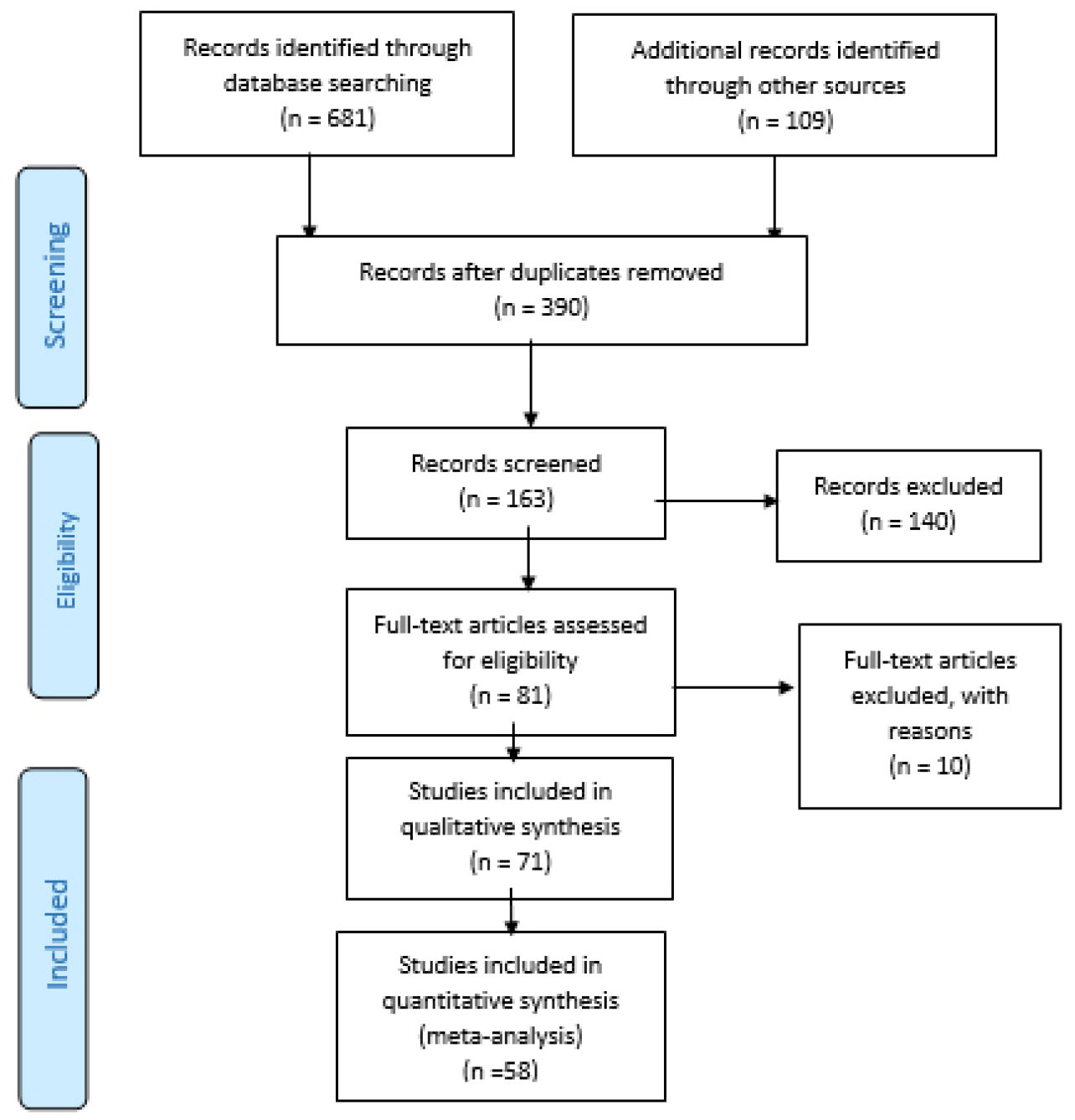
Figure 5.
An overview of the research process, showing the number of papers identified at each stage (PRISMA flow diagram, under Creative Commons Attribution Licence [43].
The review excluded redundant studies. For example, if there are two studies from the same authors using the same methodology, an example of the excluded articles. Despite their distinct differences, all the studies utilise the same framework developed by a single author, ensuring that the indicator categories are not duplicated. Regarding the exclusion criteria, each study that met the criterion of multiple authors using the same frameworks or citations of those studies was counted as unique authors using this framing in the analysis. The same author’s duplicate framework, however, was not included in the first instance since it shows that the researcher is still using their framework.
Included Studies
After selecting documents for systematic review, quality verification of the analysis performed on the chosen research papers is performed. For descriptive analysis of the home metabolism literature, consistent metadata was initially imported into Microsoft Excel. Hence, a comprehensive content analysis was performed to classify and examine the main investigation of the contents, emphasising potential problems and opportunities for future studies. Content analysis is a method of document analysis that seeks to describe and quantify the content of clear communication about predetermined groups in a systematic manner, allowing for the inclusion of reproducible and valid texts.
The literature was selected after filtering the results. First, 681 articles focusing on household metabolism in general were selected based on the content of their abstracts, titles, and keywords. The articles were classified based on subject (environmental science and social science), source type (journals, reports, theses, electronic books), document type (article, review, thesis), and language (primarily English, except for articles in other languages or incomplete papers), resulting in a total of 71 articles. Ultimately, these publications were studied in-depth using qualitative content analysis, and only those that provided particular information and related to the household food metabolism idea were chosen. The articles that were excluded from this study are out of the scope of household food metabolism and focus on areas not related to the research goals and research questions. We deleted the articles that did not deal with the household metabolism of food waste. This filtering process resulted in a total of 58 articles. Then, a modified context, indicator, mechanism, and outcome (CIMO) technique was used to systematically record article information relating to the research’s main goal. In this case, context (C) refers to the research abstract, background, and goal; indicator (I) is the quantification component of each aspect and is the intervention part of the original CIMO approach; a mechanism (M) is a method for measuring or evaluating an indicator; and outcome (O) refers to the expected impacts that can be applied.
Results and discussion
This systematic review examines the methods employed, the description of metabolic patterns across various length scales, and the conflicts that emerge when interpreting these patterns in relation to socioeconomic factors. Ultimately, the study highlights key challenges and gaps, presenting a range of important opportunities and issues for further research in this area.
Overview and general patterns
Urban household metabolism studies are a growing research field, with a high peak number of publications in 2014, as shown in Figure 6. Many old articles from 1998 have been republished in books, but those were not duplicated in 1998. So, the majority of household metabolism occurred in 1998.
Figure 7 shows the most cited household metabolism authors’ article study areas.
The distribution of frequencies of the techniques employed in the research is shown in Figure 8.
From Figure 9, studies show that developing countries are more difficult to find.
The most published journals and electronic books on the household metabolism field were done in European countries and China, as indicated in Figure 10.
Urban Household Metabolism
Cities can be examined at household levels, which is the smallest structural level [45]. It is useful to first analyse smaller components within a city by studying household metabolism [33, 46]. Only the inputs and outputs of the household are of importance in the “black box” concept of metabolism. Because families determine a large portion of consumer behaviour, the majority of the environmental burden in the economy can be attributed to them [26].
As cities develop and require resources to produce stocks (such as buildings and infrastructure), they tend to have higher inputs than outputs; over time, building-up stocks accumulate into waste streams as they degrade. As cities grow, the number of inputs and outputs becomes increasingly similar, and activities like reuse and recycling have a bigger impact on the intensity of urban metabolism [47, 48]. The pace of household metabolism is determined by several factors, including family income, local resource availability, values, and legislation [28, 49], such as family income, availability of local resources, values, and legislation.
Household metabolism is “the integrated patterns of resources from nature that flow through and out of homes [26],” according to Biesiot and Noorman (1999). Household metabolism was defined by Donato et al. (2015) as the biophysical evaluation of a household’s raw materials, energy carriers, water needs, emissions, and wastes produced by patterns of household consumption [50].
All the materials, energy, and waste that circulate through a home are collectively known as its metabolism [28, 29, 49, 50, 51, 52]. Through indirect and direct analysis of substances, household metabolism analysis can be used as a foundation to examine different environmental management measures, energy flow analysis and their by-products, and identification of the main factors of this metabolism [53]. Household metabolism includes three components: materials and products that enter homes, discarded products and waste that leave homes, and changes in the stocks of materials and products inside households [28, 50, 52]. The Household Metabolism Concept Model includes three types of fluxes: water, energy, and matter, as shown in Figure 11. The socioeconomic characteristics of a household may have an impact on its metabolism [28]. The metabolic framework explains ignored ‘output’ mechanisms such as distributing food and food waste redirection that contribute to the environmental influence of household food waste [54].
The household food metabolism, sustainability, and environmental management
Concerns regarding the environmental effects of food consumption, such as resource depletion and greenhouse gas emissions from food waste, are growing. Food intake has a tremendous impact on the environment. Changes in consumption patterns have been identified as critical stages towards achieving long-term sustainability.
In recent decades, a growing number of studies have been conducted on household consumption from various perspectives, including environmental studies that are relevant to household metabolism [28, 41, 49], and related policies [28, 41, 49, 55, 56, 57].
Household food consumption accounts for 11-19% of total consumption, according to [58]. While the [59] study considers GHG emissions from household use, a broader analysis across Europe was undertaken in 2006. According to this report, GHG emissions account for 31% of food, beverage, cigarette, and drug consumption [59].
The majority of the energy consumption and GHG emissions in the country come from household activities, as well as the transportation of goods and services to homes and the management of household waste [28]. According to studies, food consumption accounts for the greatest portion of a household’s total energy requirements, accounting for 20-35% of total energy consumption. Food consumption accounts for about 16% of total household material flow, and emissions account for about 29% of total GHG emissions, with animal products accounting for the most, animal products have a high GHG intensity, as evidenced by the 22% of emissions attributable to 5% of total consumption. This finding quantifies both the indirect and direct effects of consuming these products [53]. Between 1985 and 1990, food and housing consumption practices in China accounted for more than 80% of household environmental impacts [60]. The majority of household metabolism research attempts to make significant contributions to the sustainability transition by lowering household metabolism rates [29].
Three components make up the household food metabolism: input (such as food from retail stores or gardens), metabolic processes (such as food preparation, cooking, storing, eating, and reusing), and output (such as donating uneaten food, getting rid of spoils, and human waste). One could think of the food flows in the home as a component of the metabolism [61]. The direct flows and indirect resources needed to enable household consumption make up household metabolism [49]. Food flows are frequently included in studies on household metabolism, despite the fact that few of these studies have explicitly addressed the food part of household metabolism. Nonetheless, a number of studies on household food waste have been carried out from a non-metabolism standpoint. Garbage trucks pick up neighborhood waste, for instance, but there are other ways to gather waste data, like food waste. [62]. In addition to what is mentioned, a standardised method for collecting household-specific waste data does not exist [63].
In Hungary, Dombi et al. (2018) investigated the socio-economic metabolism structure and its drivers at the household level [64]. The studies reveal that household size and income are the primary factors influencing material inputs and stocks, suggesting that enhancing manufacturing processes could mitigate multiplier effects, especially within food supply chains [64]. Di Donato and colleagues (2015) look at household metabolism research to see whether it can go beyond the primary emphasis on energy and greenhouse gas emissions to include additional material flows that support and can be attributed to consumer spending [50].
Environmental Impact of Food Consumption
A series of publications by researchers on household metabolism link consumption to environmental pollution. There are increasing trends in per capita resource input and waste production; such studies were conducted in China [32]; Sweden [65]; Bangalore in India [66]; Singapore [67], and Israel [53].
The impact of household consumption on the environment can be directly assessed through ecological footprint analysis. For instance, a study in York City by Barrett et al. (2002) revealed that 22% of food brought into York goes uneaten and ends up in landfills, contributing significantly to the city’s ecological footprint [68]. In China, research by Zhiying & Cuiyan (2011) highlighted a concerning trend where per capita ecological carrying capacity is in deficit, particularly worsening from 2002 to 2007, emphasising the need for environmentally friendly consumption practices [69]. Similarly, a study in Mumbai by [18] found that over 30% of food brought into the city is wasted, with domestic garbage constituting a significant portion.
Food production has both direct and indirect environmental consequences. The energy used in food production (embodied energy) is thought to be a good measure of the environmental influence because many environmental issues, such as climate change, are linked to food production. According to studies, food consumption accounts for 20-35% of a household’s total energy use. Barrett et al. (2002) state that the total ecological footprint of food consumption includes both the actual pasture or cornfield area needed to produce the food and the theoretical “energy land” area required (to sequester carbon from CO2 emissions linked with its embodied energy) [68].
Certain studies focus on the consumption process at home [70]. There aren’t enough systematic data on the materials needed for homes, other kinds of emissions, and wastes besides CO2. Studies that take into account emissions and losses other than CO2 are rare [48].
Few studies specifically address food consumption in household metabolism, with the majority of studies focusing on energy consumption. Whereas there are exceptional studies, the study carried out by [71] examined the movement of C, N, and P within homes, taking into account the nutrients found in food and its waste, and found that 61% of N and 85% of P, but only 5% of C input, occur via household food, which suggests that making some changes in household consumption behaviour will lead to a great reduction of C, N, and P fluxes without major lifestyle changes.
Food consumption is the primary source of phosphates, which develop less than threefold with consumption. Nonetheless, the metabolism of phosphorus in household consumption as a system has not been clearly described and needs further in-depth study [72]. Phosphorus would accumulate in the urban environment due to rapid urbanisation and economic development, as well as limited waste disposal capacity [73].
Variability in household energy demand has been researched in cities or regions using the urban/regional metabolism framework, such as in Europe [28, 74, 75, 76, 77, 78]. Smaller households consume more resources per capita [74]. According to a study of Norwegian household metabolism, a person in a one-person household consumes approximately twice as much energy as a person in a four-person family. Throne-Holst and colleagues [74]. By analysing both the direct and indirect demand for energy (for example, the energy embodied in goods and services), according to the household metabolism principle concept, these input flows are related to generating waste residues as an output. Indirect energy use is defined as the energy needed to produce and transport goods, such as food, to the house [28, 74].
The Czech Republic’s household consumption patterns of food, water, and energy have been studied in relation to their environmental impact [79].
After researching energy needs in Northern European cities, including Swedish cities, Moll et al. (2005) came to the conclusion that all nations had substantial energy expenses in the food category and that indirect energy consumption was highest overall, second only to transportation and recreation [28]. A highly separated count of the water, energy, and goods flows—including food—in a selection of households was the goal of Harder’s (2014) studies [80].
Rosado & Ferro (2008) found that food, beverages, tobacco goods, and chemical and non-metallic products account for the majority of household energy use and CO2 emissions [81]. When embodied energy is compared to home energy use, it is obvious that embodied energy accounts for more than half of overall energy consumption, indicating the need for policy and efficiency measures [81].
Large energy and water inflows are identified in a Macao energy study [82], with heat dispersion due to waste incineration as the dominant solid waste management strategy and the largest contributor to energy loss. One of Lei and colleagues’ recommendations is to capture and reuse the heat energy for local electricity generation [82]. They also advocate incorporating trash reduction measures to reduce incineration’s negative environmental effects.
The studies within the field of socio-economic metabolism focus on the macro-level approach to household metabolism, which involves resource use and emissions driven by aggregate household consumption. In most cases, energy usage and emissions of GHG are the primary foci of the investigations, as highlighted by [50] and [83].
Although Dutch householders are willing to accept almost all energy-saving policy measures, they also show their willingness to pay more to maintain their comfort and pleasure while reducing the environmental impact of their consumption than if they were to give up some of their quality of life, according to psychological and behavioural studies examining the relationship between consumption and environmental awareness [84]. Quality of life indicators (QOL) have been used in some studies for evaluating the impacts of social and psychological barriers, environmental conditions, and consumption, as in [84] study.
On the other hand, respondents appeared to be more prepared to pay to maintain their comfort, independence, and enjoyment while minimising their consumption’s environmental impact than to give up some of their quality of life. Dürrenberger and Patzel (1999) found that technology still has a significant decrease in potential for energy consumption compared to food consumption when studying direct and indirect energy consumption in Swiss households [85]. They measured the sustainability of food consumption using measures such as per capita energy uses for food consumption by product categories. They claim that behavioural and lifestyle changes have a greater impact on food and mobility consumption sustainability than technological advancements. The drivers of household food consumption choices that are sustainable, as established in the literature on sustainable consumption, are presented in Figure 12.
For sustainability, household metabolism investigates focus on ordinary consumption, which is often excluded from consumption studies [59]. Many other kinds of research employing input/output frameworks have been conducted on sustainable consumption. Regarding the importance of food, shelter, and mobility as the most energy-intensive categories, [87] and [88] reached the same conclusion as [75] and [28]. The study by Carlsson Kanyama et al. (2005) highlights the challenge posed by varying levels of available information across European countries [75]. Some statistical organisations collect disaggregated regional data on material extraction and consumption through bottom-up or input-output (IO) analysis, contributing to the complexity of comparative analysis. This disparity makes comparative analysis more complex and underscores the necessity for systematic and standardised data collection methods.
One of the household metabolism studies shows that Northern European householders are consuming at unsustainable rates [49].
According to one of the home metabolism studies, Northern Europeans consume at unsustainable rates. In terms of initiatives, the ToolSust (Instruments for Eco-Friendly Homes in Tomorrow’s Cities) project published a report on household metabolism for five European cities in 2003, which emphasised the interactions between lifestyles and household metabolism patterns as well as the implications for sustainability [74].
Harder and colleagues (2014) devised a smartphone application for tracking food purchases and consumption and the generation of food waste [80].
Frostell et al. (2015) suggest a programme to model “household metabolism” and its carbon footprint, which covers transport, purchases, energy use in the home, and more [46]. They present it as a web-based “footprint calculator” of “household metabolism, and they named the tool EcoRunner, which uses bottom-up and top-down methods to address household metabolism while taking environmental pressures into account. The study measured the average single Swedish household expenditures and explored options for reducing the impact. The assessment shows significant environmental impacts arising from food and drink, alcohol-free beverages, and gasoline for private vehicles (e.g., a car), and air transport. Another initiative called the HOMES project addressed household metabolism as an effectively sustainable project. The project aimed to diagnose and evaluate household metabolism in the Netherlands [49, 89].
Food Waste
The reduction of metabolic fluxes, i.e., resource inputs and waste outputs, is necessary for a city’s sustainability. This will improve human living conditions, including social amenities and health. Household metabolism is the subject of a wide range of studies, many of which aim to identify factors that influence the pace of household metabolism or reduce household metabolism rates by promoting more sustainable consumption patterns. These studies, which are frequently discussed in the social sciences, go beyond family metabolism and focus on behavioural elements of consumption, consumption choices, and household habits, among other things.
Household waste and emissions are another important aspect of household metabolism and the associated environmental aspects. According to Newman (1999), wastes can be managed, but energy is needed to convert their contents into any aspect useful, and in the end, all materials will become waste [90]. According to [90], all carbon products will ultimately end up as carbon dioxide, and this cannot be recycled again without massive energy inputs, which in themselves have associated waste.
Food waste produced from resource consumption represents the largest fraction of municipal solid waste worldwide. Food waste in consumer households is a sustainable development challenge [91]. Food waste has significant environmental, economic, and social impacts [31]. Since the bulk of food waste occurs at the point of household consumption, food consumption is accountable for 33% of the environmental impact on global warming, 69% on terrestrial acidification, and 29% on eutrophication of freshwater [92, 93].
MFA has evaluated the Swiss household’s metabolism since the early 1990s [94]. According to Brunner& Rechberger (2016), solid food waste ranges from 5-10% of purchased food and beverages [94].
According to Barrett et al.’s (2002) study on York City, over 20% of all food and drink that York residents bought were disposed of in landfills [68].
Waste influences the amount of indirect energy consumed and shapes current patterns of consumption. The total of all of the indirect and direct energy requirements would be the outcome in the case of household energy metabolism [28].
According to Moll, in order to promote sustainable consumption, “quantification of the environmental load related to consumption is required” [28]. Therefore, rather than imposing new behaviors from the outside, it’s critical to comprehend household dynamics in order to influence waste production. Therefore, researching metabolism offers a great chance to learn about household dynamics and develop long-term solutions.
Domestic consumption is a major environmental issue because it leads to abuse of resources and waste management [28, 42, 49, 58].
Examining the energy needed for food production, processing, packaging, transportation, and disposal serves as a good example. Every step involves energy, and when that energy originates or is derived directly from fossil fuels, greenhouse gas emissions are released as a result. All of these activities can be taken into account by the household metabolism approach, which can also comprehend the true effects of material flows, ecological footprints, CO2 emissions, and households. It is only after that that strategies and solutions to lessen their effects can be identified. This offers a chance to formulate the precise policy goals required to finally decouple the environment and the economy [68].
Certain kinds of waste, such as packaging materials and food waste, are expected to enter the waste flow in the year of the product’s purchase. It is assumed that changes in product lifetime combine effects due to the manufacturer’s design age and household metabolism effects. Waste models that arise for goods with relatively long product lives and that utilise the household metabolism model are illustrated through waste [78].
To decrease food waste, the causes of avoidable production of food waste could be looked into. Which portion of solid waste adds most to waste generation could be estimated using data from gathered recyclable solid waste. To calculate the amount of avoidable and unavoidable waste of food as bio-waste, the packing intensity (i.e., packaging material per unit of item) of every item could be calculated using the data accessed from recyclable solid waste.
Feng (2012) carried out a pilot study that presented a number of challenges in order to determine the metabolism among two Swedish houses by collecting organic and recyclable waste and purchase receipts [95].
Overview of the Household Metabolism Assessment Methodology in the Literature
Household metabolism is measured in terms of physical flows (both direct resource flows through households and indirect flows required to meet household consumption) and environmental consequences. Several studies examined residential material and energy flows as well as industrial and megacities, resulting in an estimate of environmental implications. EIA [53, 82, 89, 96, 97]. Top-down methodologies that reveal the aggregate metabolic size of the entire home sector and bottom-up methods that explore micro-level consumption patterns in families have been employed to quantify household metabolism. The first method calculates the average materials and energy directly entering households, along with the indirect footprints from household material and energy usage. According to [50], this is accomplished through economy-wide (EW-MFA) and environmental extended input-output analysis (IOA). Based on questionnaire surveys or daily usage diaries kept by individual households, the latter creates inventories of material and product flows as well as in-use stocks [29, 80]. Top-down studies seek to provide broad perspectives on how households influence society’s overall resource exploitation and environmental emissions. On the other hand, bottom-up studies seek to provide additional information about product-level metabolism patterns that are connected to household consumption patterns and lifestyle. In comparison to micro-level indicators, macro-level indicators based on (MFA) have been more commonly used and explored [50, 64, 83].
According to Hertwich (2011), home metabolism studies currently rely on (IOA), a method that facilitates rapid assessment but is insufficiently thorough in modelling changes [58]. Input-output (I-O) analysis offers various advantages, including data availability, the capacity to operate on multiple scales, and the possibility to combine it with other methodologies (e.g., LCA) to provide better data.
To quantify home metabolism, a wide range of approaches have been used. The approaches most commonly used are environmental input-output (I-O) analysis, life cycle assessment, and the utilisation of economic, environmental, and expenditure data. The bottom-up approach of life cycle assessment (LCA), also known as the supply chain approach, is employed in the quantification of household metabolism through the compilation of inventories of material and product flows and in-use stocks, which are derived from questionnaire surveys or daily consumption diaries kept by individual households [29, 50, 53, 80].
I-O analysis-based household studies are difficult because some commodities cannot be quantified by volume or weight and some goods are subject to environmental pressure. In addition to what has been stated, it is restricted to utilising expenditure for a variety of reasons, including the fact that different retailers have varying pricing, resulting in different quantities and environmental repercussions [53].
There are methods like environmentally extended (IOA) and economy-wide (EW-MFA) that help measure the materials and energy used directly by households and the indirect impacts of household consumption. These methods shift resource consumption and emissions from different industries to household consumption. This approach is known as a top-down method for measuring household metabolism [29, 50, 80].
According to Baynes et al. (2011), the use of both method-IO usage and embodied energy for overlapping policy applications is complementary and useful [57]. The regional energy evaluation pertains to economic structure, metropolitan economy management, and prospective changes in urban production, whereas the IO results are more relevant to managing consumption behaviour and consumer responsibility.
Use of an (IOA) to convert emissions-related expenses through macro- and sectoral conversions has been the main method for most metabolism studies, which have used household expenditure records to convert them to emission or natural resources [56, 98, 99]. The term “household metabolism” refers to the resources demand that are directly required in households, such as food and water for drinking and cooking, as well as the supply of resources that are indirectly necessary in households, such as energy needed to make items [28, 46].
In a hybridised methodology, bottom-up and top-down methodologies can also be combined. As a result, a hybrid technique has emerged based on data from LCA’s IO process analysis, household expenditure surveys, and prices of products and services (IO-Process) [41, 50] employed hybrid LCA methodologies as a comparative tool for family consumption in several European nations.
Leray et al. (2014) suggest that combining both (MFA) and social practice theories (SPT) conceptual frameworks provides valuable insights towards more sustainable food systems [66]. While MFA describes and measures food consumption at the household level, SPT is used to investigate how individual, technological, and social aspects of food practices structure and constrain household food metabolism [66].
At the methodological level of environmental accounting, the household metabolism model includes significant components. It includes the indirect energy embedded in items at the ultimate consumption stage and the energetic input of capital goods and foreign commerce, giving a helpful hybrid LCA-IOA model.
Qualitative analysis of material flow samples from a small number of homes has been the focus of numerous studies that have investigated household metabolism (less than 30) [52, 100, 101], in contrast, [28] examined it in five European nations using a top-down approach to allocate macro-scale material flows to consumption. They found that the consumption of food and transportation recreation shows the largest
As in [28, 75] look at different home categories, but average households from four different nations are also compared in terms of their spending and energy requirements (the Netherlands, the UK, Sweden, and Norway). To do so, the EAP database (Life cycle energy use and GHG emissions software for household consumption goods) was adapted to differences between countries; however, the adaptation was not complete, which could result in large doubts.
Yang et al. (2012) used questionnaire surveys to collect data on renewable goods by total food expenditures, food structure percentage, food price, and population to deal with household metabolism and cross-border environmental effects between the urban core of Xiamen, China, and its urban footprint region [89].
Policy
Household metabolism has been claimed to be critical to regional sustainability and low-carbon policies [102, 103].
A study by [104] found that the annual carbon footprints of each household member’s in-home food consumption range from 0.08 - 5 t CO2 eq. Disparities in meat and dairy consumption explain most of the differences between high-and low-impact households [104]. The food category was identified as a key source of emissions, with animal items taking the lead. Policy initiatives focused on lowering meat and dairy consumption can do two things: reduce food-related emissions while also encouraging a better lifestyle. Economic (for example, taxing meat and fat goods), regulatory (for example, simplifying sustainable product distribution), informational (e.g., labels and campaigns), and behavioural policy tools are all examples of policy tools (for example, lead by example) [53]. Another study done by González et al. (2011) also adopted strategies that aim to reduce the contribution to climate change by suggesting measures that encourage feeding a growing world population a vegetarian diet with a focus on consuming vegetable products with high protein content that have a low environmental impact compared with meat products [105]. Barrett et al.’s (2002) study recommends composting green waste, which contributes to sustainability [68].
Policy recommendations for reducing phosphorus discharge in the environment should include a low-phosphorus diet, the promotion of low-phosphorus or no-phosphorus cleaning detergents, and the importance of efficient garbage treatment and sewage treatment infrastructure construction [73].
The combined analysis of the input-output (bottom-up) and regional (top-down) approaches used in the Melbourne metropolitan area showed that the regional production and IO consumption approaches, which target economic restructuring and consumption behavior, respectively, have particular relevance to policies. It is recommended that a combined analysis be used to comprehend urban energy futurism due to their complementarity.
Understanding who is responsible for what items and in what quantities and the crucial information needed to set appropriate resource usage reduction goals will aid policymakers in comprehending the important dynamics of household metabolism.
Many studies focused on the significant role of packaging and its functions for food waste in households. For example, the Wiliams et al. (2012) study found that about 20-25% of the food waste was related to the packaging design attributes [106].
An economy-wide material flow analysis of Paris [107] undertaken at several scales demonstrates that the city centre consumes more food and commodities than the suburbs around the city, which consume more fossil fuels and construction materials. New public policies on waste management and agricultural plans to employ local fertilisers and enhance local food production are among the recommendations [107].
Household waste arising depends on the gross mass of material entering households, the nature of the commodity, its packaging, and the time for which the commodity resides in the household before being discarded. It is reasonable to assume that all food packaging has a short lifespan (less than one year). This illustrates the influence of household metabolisms and how the model can be used in waste management planning [108].
Kissinger and Damari (2021) state that most metabolism researches focus on a few homes rather than a society or country’s metabolism [53].
The accuracy of the findings is improved by using numerous National Household Expenditure Surveys, which gave a fairly wide population sample. It can also help with the ability to scale up the study from the specific families studied to the entire population, which is important when deciding on environmental policy.
According to previous studies, the consumer phase accounts for 11-19% of the environmental influence of food [50, 58]. One of the high-impact behaviours is reducing food waste. Cutting out all avoidable food waste reduces emissions by 12% [55]. Firmansyah et al. (2017) emphasised the necessity of collecting and processing kitchen garbage, which has a good impact on reducing the amount of waste moved to open-dump landfills, potentially reducing N leaching from landfills, and enhancing groundwater quality [109].
The challenge for cities is to move from a linear perspective (i.e., where resources and waste enter and exit the city boundaries, respectively) to a networked and cyclical perspective, as waste becomes a new input, reducing reliance on the hinterland for resources. A circular metabolism approach would reuse waste outputs as new inputs to meet the city’s needs and reduce dependence on raw materials [110]. Because N and P nutrients are lost to the environment, switching from a linear urban metabolism to a circular metabolism in which N and P from home waste and wastewater are recycled in farms is a good example [109].
While some policy attempts have been made to redress this problem (such as encouraging green shopping by using recyclable bags and compact fluorescent lights), these initiatives remain unknown.
When studying household consumption as a linear metabolism, the implication may be that disposal becomes a consequence of primarily obtaining. But suppose the idea of household metabolism is combined with the theory of practice. In that case, we will get positive results and become the centre circle. Thus, we are not related to reducing consumption but to consuming sustainably, which can be promoted by legislation that facilitates a circular economy and prevents waste, as shown in Figures 13 and 14.

Figure 13.
Quantifying the environmental benefits of a waste prevention activity at the household level [111].
Connecting the stock and flow components of household metabolism to investigate household in-use stocks can reveal not only the distinctive features of household consumption upgrades and quality of living advancements but also potential implications for environmental protection, waste management, and sustainable green consumption in the household sector targets for an increasingly urbanised society [113].
Conclusion
The current paper sets out to review empirical, peer-reviewed studies on households’ metabolism and food consumption and their relation to environmental impact, waste production, and sustainable household practices. These drawbacks emphasised the methods used for assessment, analysis, and the suggested measures. Household metabolism in developing countries may have a variety of dynamic characteristics that reflect both social indications of success and shifting environmental repercussions resulting from household consumption. A study of household metabolism in many European cities, including Norway and the Netherlands, found that smaller homes utilise more resources per capita than bigger households, with a one-person household consuming nearly twice as much energy as a four-person household. Therefore, household metabolism evaluation is an important concept for urban development that helps resource efficiency transition.
Although several studies have used advanced modelling tools to examine household consumption in terms of sustainability and related environmental implications, the degree of cross-border environmental impacts remains unknown. Furthermore, such data have not been turned into complete management plans for cross-border environmental challenges and domestic consumption and waste reduction choices. It is still difficult to achieve sustainable home consumption patterns; therefore, an integrated strategy can aid in taking appropriate measures in this direction. Advances in recycling and recovery rates will only substantially address the problem if resource productivity and material consumption rise. As a result, it is determined that under the waste hierarchy, packages from food product inputs should be decreased at source, and incentives should be in place to enable more sustainable household use. To fully differentiate between lifestyle groups in consuming food, where needs and preferences drive a household’s options, it’s necessary to comprehend the preferences, opinions, and social consequences for metabolism. More research is needed to connect household metabolism research with a better knowledge of social, behavioural, and lifestyle factors that influence consumption habits.
Limitations and Recommendations
Some information is unavailable on a household scale, but it is critical for understanding lifestyle choices. As a result, the research was limited by the lack of data and the necessity for consistent data gathering. In order to conduct a meaningful study, the sample size must be increased in future investigations.
Most research centred on developed countries, while only a handful looked into household metabolism in emerging countries throughout the rapid urbanisation process.
The ’truncation mistake’ in the LCA approach causes substantial underestimating of total impacts when applied to home consumption. In contrast, top-down evaluations use (IOA) and are able to allocate emissions across different sectors while accounting for the national economy as a whole. Consequently, this approach has the benefit of not underestimating global data; however, the calculations are restricted to economic sectors as opposed to individual items. Consequently, a hybridized methodology combining top-down and bottom-up approaches is required to evaluate GHG emissions and energy consumption. In order to determine the impacts over an inventory of operations and purchases, ‘bottom-up’ approaches use process-based (LCA) methods. These methods involve adding up estimations of emission related to specific items and assets used during production. The study found that a new hybrid LCA-IOA tool can replace environmental pressures associated with household usage for a given population—be it a city, region, or country—by estimating the entire energy needs of households. Despite utilizing an IOA, which is inherently a top-down assessment method, the hybrid approach prioritizes the bottom-up method as it progresses from micro (home) to macro (varying sizes of social aggregation).



